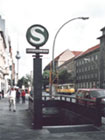City Facts
Berlin is situated in the middle
of the North European plain at 52° N, 13° E, 650 miles east of
London, 550 miles north-east of Paris and 1,000 miles west of
Moscow. The city covers an area of 550 square miles, stretching
24 miles north-south and 27 miles east-west. It lies at between
34 and 60 metres above sea level and has a continental climate,
which means a cold winter, brief spring and autumn, and hot humid
summers.
Around a quarter of the city is park
and forest, as is the surrounding state of Brandenburg. It
is dissected by countless canals and two rivers, the Spree and
Havel, which were used extensively in past centuries for transport
of goods and raw materials, but are now more accustomed to pleasure
and tour boats.
 Berlin
is served by an integrated public
transport system comprising 1,000 miles of bus route, 220
miles of tramline and 100 miles of underground rail track. In
addition the city has 500 miles of bicycle lane. Air passengers
arrive via three airports - Tegel,
Tempelhof or Schönefeld. Berlin
is served by an integrated public
transport system comprising 1,000 miles of bus route, 220
miles of tramline and 100 miles of underground rail track. In
addition the city has 500 miles of bicycle lane. Air passengers
arrive via three airports - Tegel,
Tempelhof or Schönefeld.
With a population of 3.4 million Berlin is approaching its pre-war
level and is the largest city in Germany. Half a million of the
inhabitants are foreigners. The largest group of these are made
up of Turkish migrant workers who were invited in the 70s, followed
by settlers from the old Yugoslavia, but there are also substantial
French, British, American, Polish, Greek and other European communities.
The cosmopolitan nature of the new Berlin is evident in the variety
of ethnic restaurants and shops, and in the largely mixed neighbourhoods
where inter-community tensions remain low.
The city workforce totals 1.5 million, of which the majority
work in the service sector, which is currently expanding. The
industrial sector is dominated by electrical engineering, followed
by the food and beverage industry and mechanical engineering.
In addition something like 25,000 smaller trading outlets employ
over a quarter of a million people. 50,000 workers are employed
in the field of culture, and the city attracts more than 3.5 million
tourists annually. The year 2000 has been an exceptional year
for Berlin, since a new record of approximately 10 million visitors
will be set, placing fourth behind London, Paris and Vienna as
the most visited cities in Europe.
The city is twinned with Paris,
Tokyo, Los Angeles, Moscow and Brussels amongst others.
Berlin Statistics:
|
Greater Berlin
|
| Total area |
88,900 hectar |
| Persons per hector |
38.5 |
| Average household size |
1.9 |
| Population |
3,425,759 |
| Median Income |
2,800 DM / EUR 1,400 |
|
Berlin West
|
Berlin East
|
| Total area |
48,575 ha |
Total area |
40,336 ha |
| Persons per hector |
43.7 |
Persons per hector |
31.5 |
Average household
size |
1.9 |
Average household
size |
1.9 |
| Population |
2,212,600 |
Population |
1,271,900 |
| Median Income |
2,850 DM /
EUR 1,375 |
Median Income |
2,800 DM /
EUR 1,400 |
Quelle: Statistisches Landesamt Berlin,
Mikrozensus April 1999
Find out how to get around, see Public
Transportaion.
© 2002-2003 Berlin Travel Service - A1 Design All rights reserved.
|